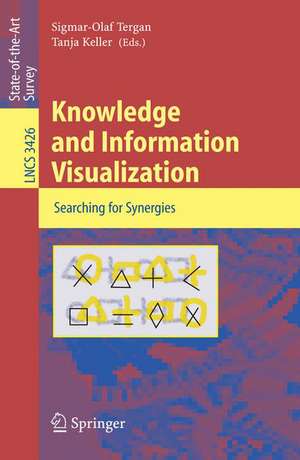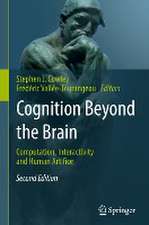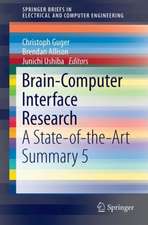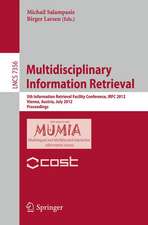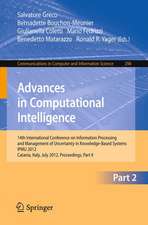Knowledge and Information Visualization: Searching for Synergies: Lecture Notes in Computer Science, cartea 3426
Editat de Sigmar-Olaf Tergan, Tanja Kelleren Limba Engleză Paperback – 27 iun 2005
Din seria Lecture Notes in Computer Science
- 20%
 Preț: 1061.55 lei
Preț: 1061.55 lei - 20%
 Preț: 307.71 lei
Preț: 307.71 lei - 20%
 Preț: 438.69 lei
Preț: 438.69 lei - 20%
 Preț: 579.30 lei
Preț: 579.30 lei -
 Preț: 410.88 lei
Preț: 410.88 lei - 17%
 Preț: 427.22 lei
Preț: 427.22 lei - 20%
 Preț: 596.46 lei
Preț: 596.46 lei - 15%
 Preț: 448.04 lei
Preț: 448.04 lei - 20%
 Preț: 353.50 lei
Preț: 353.50 lei -
 Preț: 389.49 lei
Preț: 389.49 lei - 20%
 Preț: 309.90 lei
Preț: 309.90 lei - 20%
 Preț: 645.28 lei
Preț: 645.28 lei - 20%
 Preț: 763.23 lei
Preț: 763.23 lei - 15%
 Preț: 580.46 lei
Preț: 580.46 lei - 20%
 Preț: 310.28 lei
Preț: 310.28 lei - 20%
 Preț: 655.02 lei
Preț: 655.02 lei - 20%
 Preț: 1183.14 lei
Preț: 1183.14 lei - 20%
 Preț: 340.32 lei
Preț: 340.32 lei -
 Preț: 449.57 lei
Preț: 449.57 lei - 20%
 Preț: 591.51 lei
Preț: 591.51 lei - 18%
 Preț: 938.83 lei
Preț: 938.83 lei - 20%
 Preț: 337.00 lei
Preț: 337.00 lei - 20%
 Preț: 649.50 lei
Preț: 649.50 lei - 20%
 Preț: 607.40 lei
Preț: 607.40 lei - 20%
 Preț: 1414.79 lei
Preț: 1414.79 lei - 20%
 Preț: 1024.44 lei
Preț: 1024.44 lei - 20%
 Preț: 583.40 lei
Preț: 583.40 lei - 20%
 Preț: 453.32 lei
Preț: 453.32 lei - 20%
 Preț: 575.49 lei
Preț: 575.49 lei - 20%
 Preț: 1075.26 lei
Preț: 1075.26 lei - 20%
 Preț: 585.88 lei
Preț: 585.88 lei - 20%
 Preț: 825.93 lei
Preț: 825.93 lei - 17%
 Preț: 360.20 lei
Preț: 360.20 lei - 20%
 Preț: 763.23 lei
Preț: 763.23 lei - 20%
 Preț: 340.32 lei
Preț: 340.32 lei - 20%
 Preț: 504.58 lei
Preț: 504.58 lei - 20%
 Preț: 369.13 lei
Preț: 369.13 lei - 20%
 Preț: 580.93 lei
Preț: 580.93 lei - 20%
 Preț: 343.62 lei
Preț: 343.62 lei - 20%
 Preț: 350.21 lei
Preț: 350.21 lei - 20%
 Preț: 583.40 lei
Preț: 583.40 lei - 20%
 Preț: 583.40 lei
Preț: 583.40 lei - 15%
 Preț: 438.59 lei
Preț: 438.59 lei - 20%
 Preț: 341.95 lei
Preț: 341.95 lei - 20%
 Preț: 238.01 lei
Preț: 238.01 lei - 20%
 Preț: 538.30 lei
Preț: 538.30 lei
Preț: 337.52 lei
Preț vechi: 421.90 lei
-20% Nou
Puncte Express: 506
Preț estimativ în valută:
64.59€ • 70.14$ • 54.26£
64.59€ • 70.14$ • 54.26£
Carte tipărită la comandă
Livrare economică 22 aprilie-06 mai
Preluare comenzi: 021 569.72.76
Specificații
ISBN-13: 9783540269212
ISBN-10: 3540269215
Pagini: 400
Ilustrații: VIII, 385 p.
Dimensiuni: 155 x 235 x 25 mm
Greutate: 0.56 kg
Ediția:2005
Editura: Springer Berlin, Heidelberg
Colecția Springer
Seriile Lecture Notes in Computer Science, Information Systems and Applications, incl. Internet/Web, and HCI
Locul publicării:Berlin, Heidelberg, Germany
ISBN-10: 3540269215
Pagini: 400
Ilustrații: VIII, 385 p.
Dimensiuni: 155 x 235 x 25 mm
Greutate: 0.56 kg
Ediția:2005
Editura: Springer Berlin, Heidelberg
Colecția Springer
Seriile Lecture Notes in Computer Science, Information Systems and Applications, incl. Internet/Web, and HCI
Locul publicării:Berlin, Heidelberg, Germany
Public țintă
ResearchCuprins
Visualizing Knowledge and Information: An Introduction.- Visualizing Knowledge and Information: An Introduction.- Background.- Visual Queries: The Foundation of Visual Thinking.- Representational Correspondence as a Basic Principle of Diagram Design.- Knowledge Visualization.- Node-Link Mapping Principles for Visualizing Knowledge and Information.- Tools for Representing Problems and the Knowledge Required to Solve Them.- Collaborative Knowledge Visualization for Cross-Community Learning.- Information Visualization.- Modeling Interactive, 3-Dimensional Information Visualizations Supporting Information Seeking Behaviors.- Visualizing Information in Virtual Space: Prospects and Pitfalls.- The Impact of Dimensionality and Color Coding of Information Visualizations on Knowledge Acquisition.- Synergies Visualizing Knowledge and Information for Fostering Learning and Instruction.- Digital Concept Maps for Managing Knowledge and Information.- Concept Maps: Integrating Knowledge and Information Visualization.- Comprehensive Mapping of Knowledge and Information Resources: The Case of Webster.- Towards a Framework and a Model for Knowledge Visualization: Synergies Between Information and Knowledge Visualization.- ParIS – Visualizing Ideas and Information in a Resource-Based Learning Scenario.- Knowledge-Oriented Organization of Information for Fostering Information Use.- LEO: A Concept Map Based Course Visualization Tool for Instructors and Students.- Navigating Personal Information Repositories with Weblog Authoring and Concept Mapping.- Facilitating Web Search with Visualization and Data Mining Techniques.- The Role of Content Representations in Hypermedia Learning: Effects of Task and Learner Variables.- Supporting Self-regulated E-Learning with Visual Topic-Map-Navigation.-Information and Knowledge Visualization in Development and Use of a Management Information System (MIS) for DaimlerChrysler.
